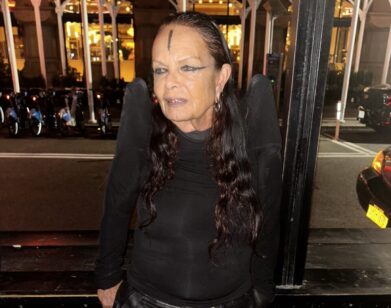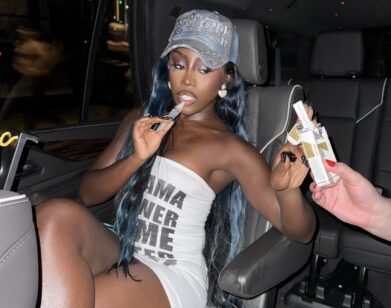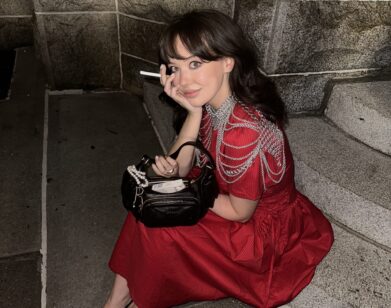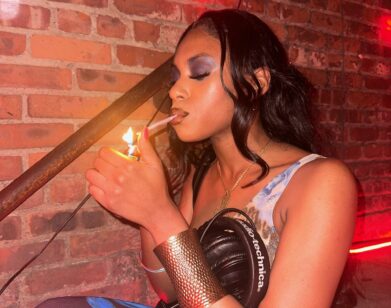SMOKE BREAK
“Gentrification Is Fucked Up”: We Got Stoned With Artist Derrick Adams
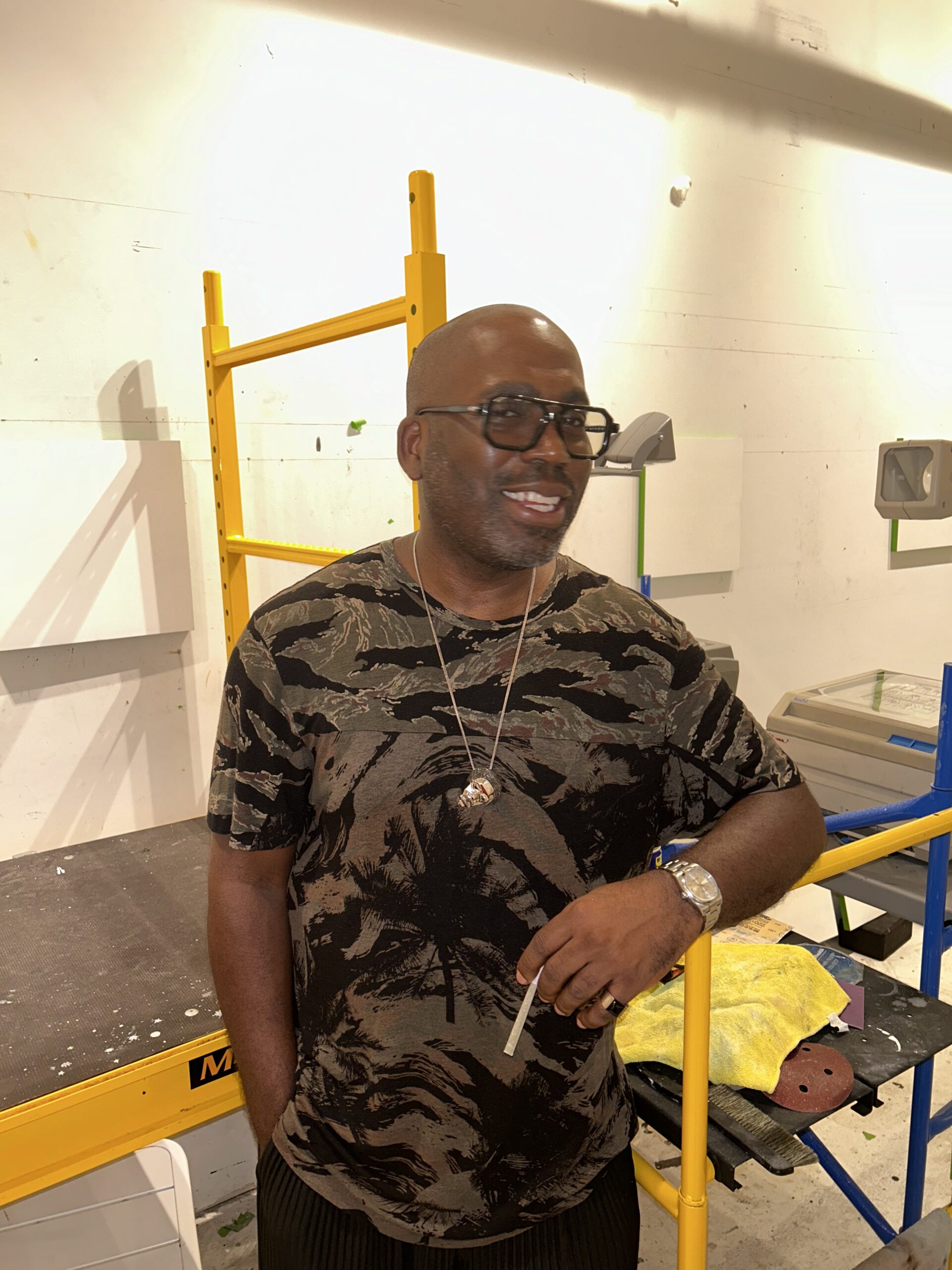
Derrick Adams, photographed by Emma Stout.
THURSDAY 10:15 PM JUNE 20, 2024 CROWN HEIGHTS
Far beyond the hustle and bustle of Manhattan, where office buildings turn into Dollar Trees and commuters become residents, you’ll find the studio of the artist Derrick Adams. The 54-year old artist works out of a Brooklyn warehouse space to make art that reflects life, but that’s not intended to be trite. His works, including “The Holdout II,” which is currently on display in Newark’s Paul Robeson Gallery, upends dominant narratives of Black people as entertainers or athletes and reinforces moments of leisure. “My work is always inspired by living in a Black space,” Adams said. “But formally, as an artist, it’s really exciting to be able to be in spaces where people who are from different, broad backgrounds are communing together.” That kind of communion was certainly the case last week, when Adams invited friends and admirers over to his studio to take an NDA-sealed peek at his upcoming projects. After a five-course dinner with cannabis pairings prepared by the first-rate dispensary Gotham, we pulled Adams aside to take a few tokes and talk about gentrification in Brooklyn, old-school cartoons, and how he unwinds after a big opening. Hint: he keeps working.
———
EMMA STOUT: So where are we?
DERRICK ADAMS: My studio here in Brooklyn and we’re celebrating Amitha [Raman]’s brand. And people are just hanging out, relaxing, having great food, smoking, having cocktails. I think everything is moving along really smoothly, and creativity is flowing through everybody.
STOUT: Did you try all of these? [Points at pre-rolls]
ADAMS: Yes, I did.
STOUT: Which one did you like the most?
ADAMS: I think the starter was really good for me. From there, I was pretty much at a good place. I actually felt very intoxicated through the food as well as the cocktails, so it was very in sync.
STOUT: I’ve never had cannabis paired with food before. That was crazy in the best way.
ADAMS: Yeah, it can be very enlightening when you’re working with a really good chef and someone who really knows the leaf and can understand how they balance.
STOUT: Are you more of a sativa or indica person?
ADAMS: It all depends. I don’t smoke when I’m working.
STOUT: Really?
ADAMS: No. I mean, my creativity is something that I find doesn’t really need to be activated. If anything, smoking for me is more like, giving me the ability to download the things that I’ve been processing throughout the day. There’s moments where I’m working in my studio, there’s moments where I’m having conversations with other like-minded people in the lounge area of my studio, which really doesn’t always surround art. It can be a lot of different things.
STOUT: How long have you been in this studio?
ADAMS: A little over three years.
STOUT: Does the neighborhood inspire you?
ADAMS: My work is always inspired by living in a Black space, and I’ve been interested in how as an artist, I can interpret it in a way that can give people some insight into how I look at Blackness through my own point of view. Some artists can communicate culture in a way that has many different aspects: they can have the joy part, the pain part, the glamor part, the normalcy part. There’s certain things you don’t have to be literal and fill in. Artists should allow the viewer to have their own interpretation of something, even if you don’t think that’s what it’s supposed to be about. But formally as an artist, it’s really exciting to be able to be in spaces where people who are from different, broad backgrounds are communing together. That’s cool.
STOUT: I wanted to ask about your piece in Newark right now, “The Holdout II.”
ADAMS: Oh, yeah.
STOUT: Does your frame of reference change as gentrification accelerates in Brooklyn?
ADAMS: I mean, the whole origin of “The Holdout II” stemmed from the legalized definition of a holdout, which is a real estate term for people who won’t sell for whatever reason. They like where they are, they don’t care what’s going on, whatever. I personally believe that in general, this is Native American property, number one. And I think that gentrification is fucked up, but if we just know the history of this country, we should not be shocked when we think about people being moved around. I’m not saying it’s right, but they took the land from someone before there were houses on it.
STOUT: Yeah, I’m half-Native, so I feel you.
ADAMS: Yeah, so everybody– Black people, Native people, white people– we need to really think about how we can rebuild on all this craziness in a more sustainable manner.
STOUT: I feel like with “The Holdout II” versus “The Holdout I,” you had the pyramid structure. But now it’s more open. What does that mean to you?
ADAMS: Well before, it was really more about myself and a co-DJ in this kind of closed space that alluded to some monumental dwelling. But when I was asked to do it the second time, it was presented as an idea that could be more expansive because of the audience. So we had to really rethink who would be there. But I think that “The Holdout” for me is not necessarily just about being able to fully secure and own your property, but understanding really the essence of what is being held out, what you possess, the things you can hold onto you to feel like you would die for this.
STOUT: How did you choose the records that you included, like Lauryn Hill and Stevie Wonder?
ADAMS: This time, I decided to lean more into creating a space where other people can host, and so I asked Andrea Clarke, who founded Sister from Another Planet, because she ran a radio program, and I wanted to bring someone in who can really think about music as genres and think about music as an intellectual relationship to the piece and the space which I created for people to occupy. So really, I just created the space, and my piece, “The Holdout II,” is really not about me making the art, but creating the space for things to happen.
STOUT: Yeah, it’s more of an interaction. How many times do you go back and visit an exhibit?
ADAMS: Once I do a show? I prefer never to go back after opening.
STOUT: Really?
ADAMS: Because usually, I’m looking at the work all the time in my studio. I spend every day with it, and I want to make more space for new stuff, so I think, “Let me just start on something else.” If you’re a doctor, you doctor. You’re a lawyer, you lawyer. So if I’m an artist, I want to make art. That’s a cool job, you know what I’m saying? Moving to the next thing, experimenting with things. It’s fun.
STOUT: Since your art deals with so much popular culture, I wanted to ask for some recommendations. What are you watching?
ADAMS: I’m not a very committed viewer. I’m more of a scroller through stuff. I watch animation more, I’m not even going to lie. I do, I love cartoons. Once I leave my studio, I want to live in a fantasy world and cartoons just really do it for me.
STOUT: What’s the best cartoon?
ADAMS: I mean, the standard shit like Rick and Morty or Bob’s Burgers. Or I watch Hey Monie! – an old, old BET cartoon on YouTube. It’s so good.
STOUT: I’ll have to check it out. Thank you for doing this and for interviewing Greg Ito recently. We love you over at Interview.
ADAMS: Thank you. You guys are the best.

